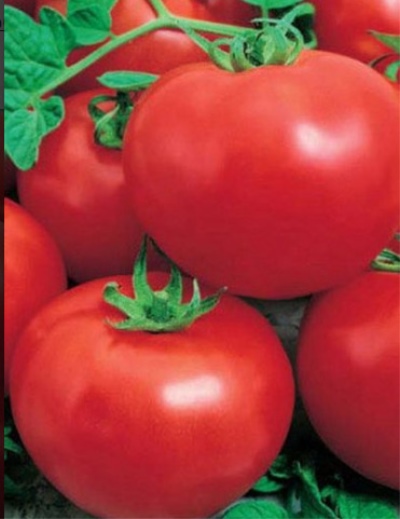
- Authors: M. Kh. Aramov, A. V. Shelobodkin, Agrofirma Allen LLC
- Year of approval: 2007
- Category: grade
- Growth type: determinant
- Appointment: fresh consumption
- Ripening period: mid-season
- Ripening time, days: 110-115
- Growing conditions: for open ground, for closed ground
- Bush size: tall
- Bush height, cm: 180-200
The Delicacy variety is a variety little known to gardeners. Differs in good productivity and ease of cultivation. Suitable for making salads, slicing, sandwiches, making ketchups, juices, for canning.
Not to be confused with the varieties Moscow Delicacy, Salted Delicacy, Russian Delicacy.
Breeding history
Created by breeders M. Kh. Aramov, A. V. Shelobodkin on the basis of LLC Agrofirm Allen. Included in the State Register in 2007.
Description of the variety
Tall bushes reach a height of 180-200 cm, compact, powerful stem. Leaves are medium-sized, green, curling, potato-like. The inflorescence is simple. 6-7 clusters are formed on one plant, 5-6 fruits on each. The type of growth is determinant. Suitable for planting in open and closed ground.
The main qualities of the fruit
Small-sized fruits weighing up to 100-120 g, round, even shape, bright pink in color. The pulp of medium density is juicy, the skin is smooth, not prone to cracking.
Taste characteristics
Dessert tomato, with a pleasant aroma.
Ripening and fruiting
Mid-season in terms of ripening, 110-115 days will pass from the moment the shoots appear until the harvest. The first tomatoes can be tasted in July, fruiting lasts until September.
Yield
4-5 kg of tomatoes are removed from one plant.
The timing of planting seedlings and planting in the ground
Planting material is sown in March - early April. The variety is distinguished by high germination. Dive when throwing out 1-2 true leaves. They are fed 2-3 times with complex fertilizer. Two weeks before transferring the seedlings to the site, they begin to harden it. Planted at the age of 55-70 days. They are transferred to the beds in April-May, when the threat of return frosts has passed. Under the film, you can plant a little earlier at the age of 40 days. In the south, it can be grown in a seedless way.

Growing tomato seedlings is an extremely important process, because it largely depends on whether the gardener can harvest at all. All aspects must be taken into account, from seedbed preparation to planting in the ground.
Landing scheme
Seedlings are placed at a distance of 70x40 cm from each other, per 1 sq. m 3-4 tomatoes grow comfortably.

Growing and care
Bushes necessarily require a garter to a specially installed trellis. They are formed into 1-2 stems, but it is permissible to lead into 3 stems. Needs to remove stepchildren to the first brush. Regular moderate watering is required in the morning or evening hours; in very hot weather, do not water so that the plant does not get a root burn. After watering, the soil is loosened, weeds are removed, you can mulch with a special cloth. The greenhouse is ventilated. They feed 2-3 during the season.




A plant needs different micronutrients at each stage of growth. All fertilizers can be divided into two groups: mineral and organic. Folk remedies are often used: iodine, yeast, bird droppings, eggshells.
It is important to observe the rate and period of feeding. This also applies to folk remedies and organic fertilizers.
Disease and pest resistance
It has a high immunity to apical and root rot. It is recommended to carry out preventive treatment against late blight, brown spot, powdery mildew. When the first signs of brown spot appear, all affected shoots, leaves and fruits are removed and destroyed. Spray with fungicide "Zaslon" in the morning and in the evening every 10 days. Powdery mildew is sprayed with a solution of potassium permanganate in the ratio: 2.5 g per 10 liters of water.
Of the pests, the Colorado potato beetle and the greenhouse whitefly are the most dangerous; the "Confidor" remedy helps from them. During flowering, 2 weeks before harvesting, insecticides are not used. From the whitefly, wash the leaves with soapy water, use glue traps, carry out the treatment with infusion of garlic, or infusion of dandelion rhizome. The Colorado potato beetle is sprayed with infusion of tobacco: for 10 liters of water - 500 g of tobacco, the soil around the bush is sprinkled with chopped onion husks. Slugs can attack the culture - the surface of the garden is sprinkled with mustard powder about 1 tsp per 1 sq. m.


Resistant to adverse weather conditions
Cold-resistant, heat-resistant and drought-resistant variety.
Growing regions
Suitable for planting in greenhouses throughout Russia, in the southern regions it can be planted in open beds.
Review overview
This tomato is very popular with gardeners for its rounded tasty tomatoes and a high yield. The shape and size of the tomatoes fully correspond to the indicated characteristics and the photograph on the package.

























































































